Chandrayaan 3: Launch and Discussions
-
Mort Walker
- BRF Oldie
- Posts: 10042
- Joined: 31 May 2004 11:31
- Location: The rings around Uranus.
Re: Chandrayaan 3: Launch and Discussions
Sulfer was detected in the samples brought back by the Apollo missions since 1969. CY3 confirmed this in in-situ experiment is the difference here. To make sulfer based fertilizer and concrete requires energy. Until there's a large nuclear reactor on the surface of the moon, that is unlikely to happen.
Re: Chandrayaan 3: Launch and Discussions
Xpost from sports dhaga -
ISRO's Somanathji at residence of Chess GM Praggnanandhaa discussing about Pragyan and replica of LVM3
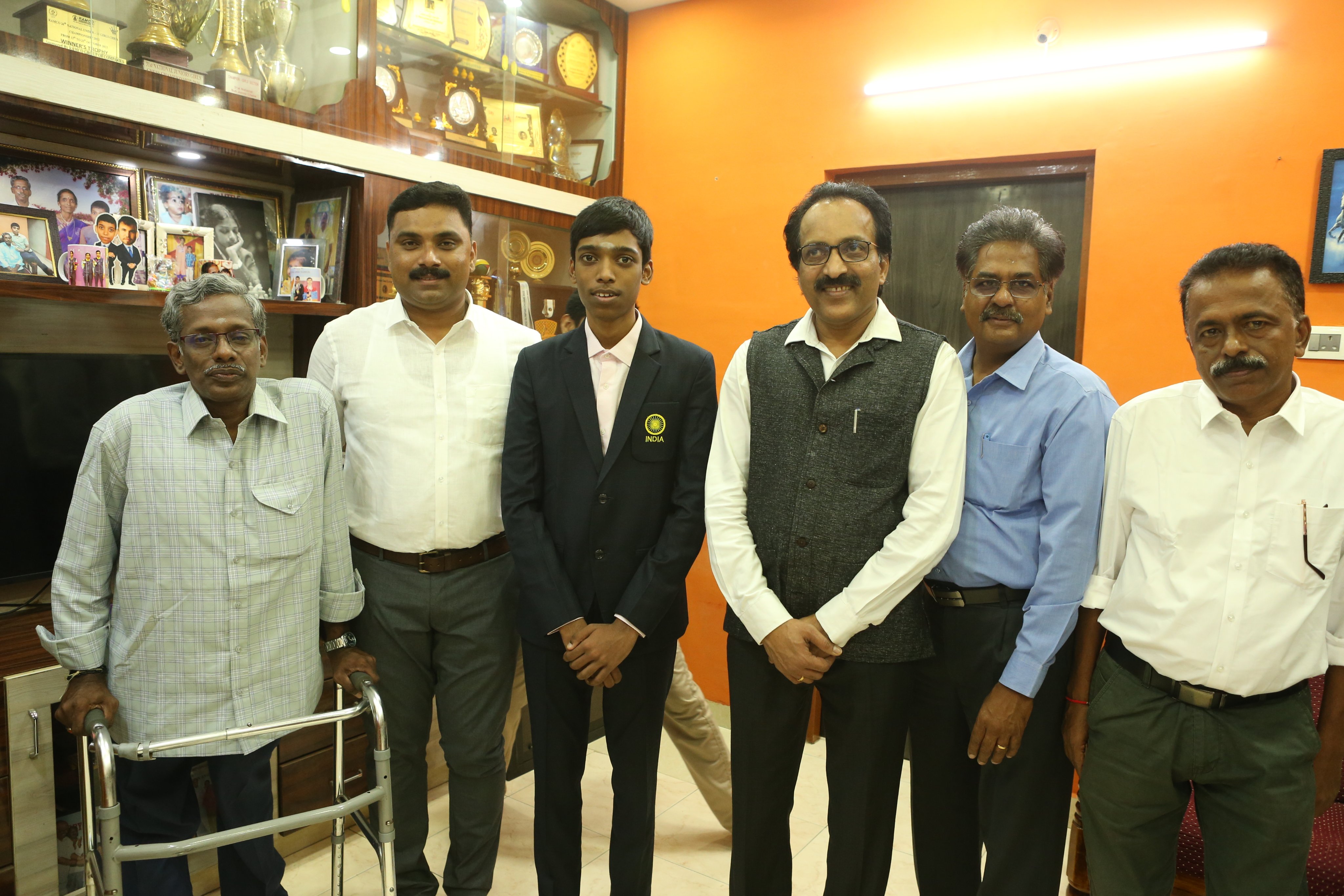
ISRO's Somanathji at residence of Chess GM Praggnanandhaa discussing about Pragyan and replica of LVM3

Re: Chandrayaan 3: Launch and Discussions
^^^Praggnanandhaa to work with @isro to promote science & technology: S.Somanath
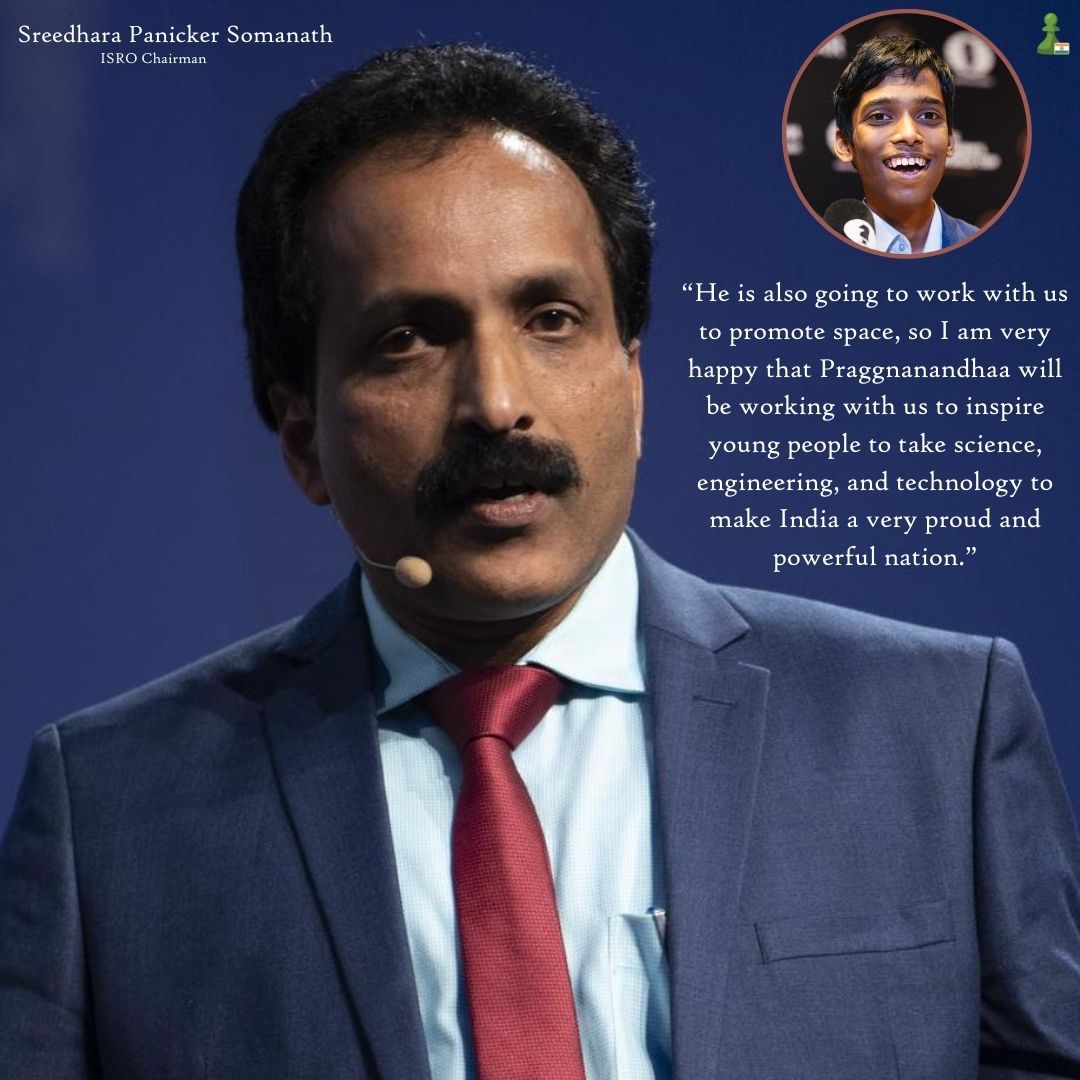

Re: Chandrayaan 3: Launch and Discussions
So no water found by CY3 on Lunar south pole?
Re: Chandrayaan 3: Launch and Discussions
^^^ CY3 has not found any direct evidence of water ice near the Moon's south pole. However, its findings have further strengthened the case for the presence of water in the region.
Pragyan discovered traces of sulfur on the lunar surface near the south pole. Sulfur is a volatile element, meaning that it can easily vaporize. This suggests that the sulfur could have been released from water ice that was heated by the Sun.
CY3 also found that the lunar soil at the south pole is very fine and dry. This type of soil is often associated with the presence of water ice, as it can help to trap and protect the ice from the Sun's heat.
Overall it has provided new evidence that supports the presence of water ice on the Moon's south pole. As usual more research is needed to confirm this finding and to determine the extent and distribution of water ice in the region.
BTW Apart from CY3 others are also exploring Moon's south pole and search for water ice. NASA's Artemis 3 mission is scheduled to land astronauts at the south pole in 2025. The mission will carry a number of scientific instruments, including a drill that will be used to collect samples from beneath the lunar surface.
Pragyan discovered traces of sulfur on the lunar surface near the south pole. Sulfur is a volatile element, meaning that it can easily vaporize. This suggests that the sulfur could have been released from water ice that was heated by the Sun.
CY3 also found that the lunar soil at the south pole is very fine and dry. This type of soil is often associated with the presence of water ice, as it can help to trap and protect the ice from the Sun's heat.
Overall it has provided new evidence that supports the presence of water ice on the Moon's south pole. As usual more research is needed to confirm this finding and to determine the extent and distribution of water ice in the region.
BTW Apart from CY3 others are also exploring Moon's south pole and search for water ice. NASA's Artemis 3 mission is scheduled to land astronauts at the south pole in 2025. The mission will carry a number of scientific instruments, including a drill that will be used to collect samples from beneath the lunar surface.
Re: Chandrayaan 3: Launch and Discussions
As it descended, the Chandrayaan-3 generated a spectacular 'ejecta halo' of lunar material. This phenomenon was captured and analyzed by scientists from the National Remote Sensing Centre (NRSC). Approximately 2.06 tons of surface material were ejected and displaced over an area of 108.4 square meters around the landing site.
Scientists compared the pre- and post-landing high-resolution imagery from the Orbiter High-Resolution Camera (OHRC) of the Chandrayaan-2 orbiter. The images were acquired hours before and after the landing event, which characterised this ‘ejecta halo’ appearing as an irregular bright patch surrounding the lander.
Characterisation of Ejecta Halo on the Lunar Surface
Scientists compared the pre- and post-landing high-resolution imagery from the Orbiter High-Resolution Camera (OHRC) of the Chandrayaan-2 orbiter. The images were acquired hours before and after the landing event, which characterised this ‘ejecta halo’ appearing as an irregular bright patch surrounding the lander.
Characterisation of Ejecta Halo on the Lunar Surface
From the mapped and classified, uncorrelated ‘ejecta halo’ pixels, an approximate areal extent of 108.4 m^2 is estimated to have been covered by lunar epiregolith ejecta displaced due to the landing sequence of the Vikram lander. Further, using empirical relations, we estimate that approximately 2.06 tonnes of lunar epiregolith were ejected due to the landing event
Re: Chandrayaan 3: Launch and Discussions
Something is Still Lurking Below the Moon's Surface | India's Chandrayaan 3 Moon Mission ISRO,,,,
Re: Chandrayaan 3: Launch and Discussions
Wow Wow Wow !!!!!! so CY-3 ji had atmi taakat I was never aware
Re: Chandrayaan 3: Launch and Discussions
^^ Remember, I talked about - Nuclear Isotopes heating units - RHU a few times here .. Saying that ISRO can employ it, if it wanted - no big deal..
As, for example .. here:
Well it turns out that CY3 PM did use RHU... not on Vikram but on PM..
(Interestingly, all technical details I gave were quite accurate about the power any type..)
Chandrayaan-3’s Nuclear energy powers the propulsion module orbiting the moon
As, for example .. here:
Amber G. wrote: ↑28 Aug 2023 21:18
...Having said that, it is not really a big deal.. or that sensational ( for newspapers/ aamjanta 'nuclear' /atomic is taken much more seriously than it ought too.)
Few comments:
RHU (Radioisotope heater unit) is not RTG (Radioisotope thermoelectric generator) - RHU is a small device, it provides heat through radioactive decay and normally provide about one watt of heat (derived from the decay of less than 2 gms of Pu-238 (Po 210 weight even less). Total mass, including shielding is typically about 40 gms. It produces heat for several decades. USA has used Pu238 (Half life ~88 years). Russia in previous lunar missions used Po210 (Half life few months). (For moon mission like CY3 Po 210 can be used)
I don't know about India ( ISRO have asked for proposals to develop units).
<snip>
Well it turns out that CY3 PM did use RHU... not on Vikram but on PM..
(Interestingly, all technical details I gave were quite accurate about the power any type..)
Chandrayaan-3’s Nuclear energy powers the propulsion module orbiting the moon
..... Now, almost two months after the momentous success, another untold success related to Chandrayaan-3 has come to the fore.
Conspicuously, the propulsion module in the lunar mission which has been orbiting the Moon is powered by nuclear technology, the Times of India reported on 31st October (Tuesday).
The propulsion module is equipped with two radioisotope heating units (RHU) that are designed and developed by BARC, I.... This cooperation reportedly makes it the first major joint project of ISRO and BARC.
These two RHUs generate one watte and keep the spacecraft at their operational temperatures.
However, the ISRO officials emphasised that the RHUs could not be installed on Chandrayaan 3’s Vikram lander and Pragyan rover because it would have increased their mass. Whereas, the RHUs were installed in the propulsion module for the purpose of experimentation and demonstration. An official said, “They have been functioning flawlessly. It’s the first major joint project of ISRO and BARC.”
Re: Chandrayaan 3: Launch and Discussions
Wait -why would an orbiting spacecraft require Radioisotope Heating Units? Never heard of any of them requiring such a thing before - because there is no 2-week long lunar night in orbit - that's something that only applies on the ground.Amber G. wrote: ↑02 Nov 2023 07:44 Chandrayaan-3’s Nuclear energy powers the propulsion module orbiting the moon
..... Now, almost two months after the momentous success, another untold success related to Chandrayaan-3 has come to the fore.
Conspicuously, the propulsion module in the lunar mission which has been orbiting the Moon is powered by nuclear technology, the Times of India reported on 31st October (Tuesday).
The propulsion module is equipped with two radioisotope heating units (RHU) that are designed and developed by BARC, I.... This cooperation reportedly makes it the first major joint project of ISRO and BARC.
These two RHUs generate one watte and keep the spacecraft at their operational temperatures.
However, the ISRO officials emphasised that the RHUs could not be installed on Chandrayaan 3’s Vikram lander and Pragyan rover because it would have increased their mass. Whereas, the RHUs were installed in the propulsion module for the purpose of experimentation and demonstration. An official said, “They have been functioning flawlessly. It’s the first major joint project of ISRO and BARC.”
What was the purpose or need of having RHUs onboard the propulsion module? Couldn't they have achieved the same with solar power?
Re: Chandrayaan 3: Launch and Discussions
^^^
RHUs have been used on a wide variety of space missions, from the early Apollo program (1970's)to the latest robotic probes. They are a reliable and efficient way to provide heat in space, (to keep electronics warm) and they have played a vital role .. No big deal .. sort of routine if one wants to.
(ISRO certainly will like to try it out .. even if they have solar panels and may not need it)
See for examle : < here >
--- China, for example, not only in Chang'e 4 rover, but also in all other Chang probes ( orbiter). used it. (So did most of NASA probes)
RHU are small - rather inexpensive and quite small in size etc (See my posts earlier about more details - or check out wiki etc)..
To be clear, unlike RTG there primary function is *not* to provide power but keep electronics warm..so they are quite helpful even if one has solar panels to provide main power..
.. RHUs are used for thermal control, providing a constant source of heat to keep spacecraft components warm, while RTGs are used for electrical power generation in missions where solar power is insufficient. Both RHUs and RTGs rely on the radioactive decay of isotopes, primarily plutonium-238, but they serve different functions in space exploration.
RHUs have been used on a wide variety of space missions, from the early Apollo program (1970's)to the latest robotic probes. They are a reliable and efficient way to provide heat in space, (to keep electronics warm) and they have played a vital role .. No big deal .. sort of routine if one wants to.
(ISRO certainly will like to try it out .. even if they have solar panels and may not need it)
See for examle : < here >
--- China, for example, not only in Chang'e 4 rover, but also in all other Chang probes ( orbiter). used it. (So did most of NASA probes)
RHU are small - rather inexpensive and quite small in size etc (See my posts earlier about more details - or check out wiki etc)..
To be clear, unlike RTG there primary function is *not* to provide power but keep electronics warm..so they are quite helpful even if one has solar panels to provide main power..
.. RHUs are used for thermal control, providing a constant source of heat to keep spacecraft components warm, while RTGs are used for electrical power generation in missions where solar power is insufficient. Both RHUs and RTGs rely on the radioactive decay of isotopes, primarily plutonium-238, but they serve different functions in space exploration.
Re: Chandrayaan 3: Launch and Discussions
Sanman, to add to above - (Use of RHU or RTG is quite common) -- except of earth orbits etc, one uses it for longer space voyages..
For those interested in technical details and physics background .. etc.. please keep reading.
Most NASA space probes have used Radioisotope Heater Units (RHUs) or Radioisotope Thermoelectric Generators (RTGs) to provide power and heat. RTGs use the heat generated by the radioactive decay of plutonium-238 to power spacecraft and keep their instruments warm...RHUs generally are there to keep electronics warm..(RHU are small - do not have thermocouples etc to generate electricity/power(
NASA has used RHUs or RTGs on over 50 space missions - starting in 1970's , including:
The Voyager 1 and 2 probes, which are still traveling through interstellar space
The Cassini-Huygens mission to Saturn and Titan
The Galileo mission to Jupiter
The Ulysses mission to the Sun's poles
The Mars Exploration Rovers Spirit and Opportunity
The New Horizons mission to Pluto and the Kuiper Belt
The James Webb Space Telescope
RHUs and RTGs are essential for missions to deep space or to planets and moons with cold environments. They are also used on some Earth-orbiting satellites and planetary landers.
According to NASA's RPS website, over 300 RHUs have been launched on a variety of NASA spacecraft. RTGs are larger and more powerful than RHUs, and are typically used on missions where more power is needed.
The same is true for Russian (or Soviet Union) - again *many* dozens probes...
Eg: Venera 9 and 10 (first spacecraft to land on Venus)
Luna 16 and 20, which returned samples of lunar soil to Earth
Phobos 1 and 2, which were missions to Mars
Mars 96, which was a failed mission to Mars
Phobos-Grunt, which was a failed mission to Phobos..
---
Chinese are using it on same scale - (Chang'e 5-T, Tianwen-1 etc).. they did not (from what I know) have technology to produce Pu-238 before and were depending on others.. but now they (CAST - China Academy of Space Technology) said that they have successfully developed a prototype RTG using Chinese-made plutonium-238. This is a significant development, as it means that China will no longer need to rely on foreign suppliers for RTGs.
---
India can produce its own plutonium-238 (Pu-238). BARC has developed a prototype radioisotope thermoelectric generator (RTG) using Pu-238, which is designed to be used on Chandrayaan type lunar orbiter.
India is strong in nuclear research and development, and it is one of the few countries in the world that can produce Pu-238. BARC has a dedicated Plutonium-238 Production Plant (P-238PP), which is used to produce Pu-238 for space applications.
The P-238PP uses a process called neutron irradiation to produce Pu-238. In this process, enriched uranium-238 is irradiated with neutrons in a nuclear reactor. This causes some of the uranium-238 atoms to absorb neutrons and transmute into Pu-238.
I have an earlier post in this dhaga about RHU - and India's status, and some ISRO slides..
(As I said earlier, Pu-238 producing is a little challenging task, Pu238 is different than Pu -239 used for 'other' purposes..)
Hope this is interesting to some folks here.. ..
..
Adding an old slide from a post earlier:
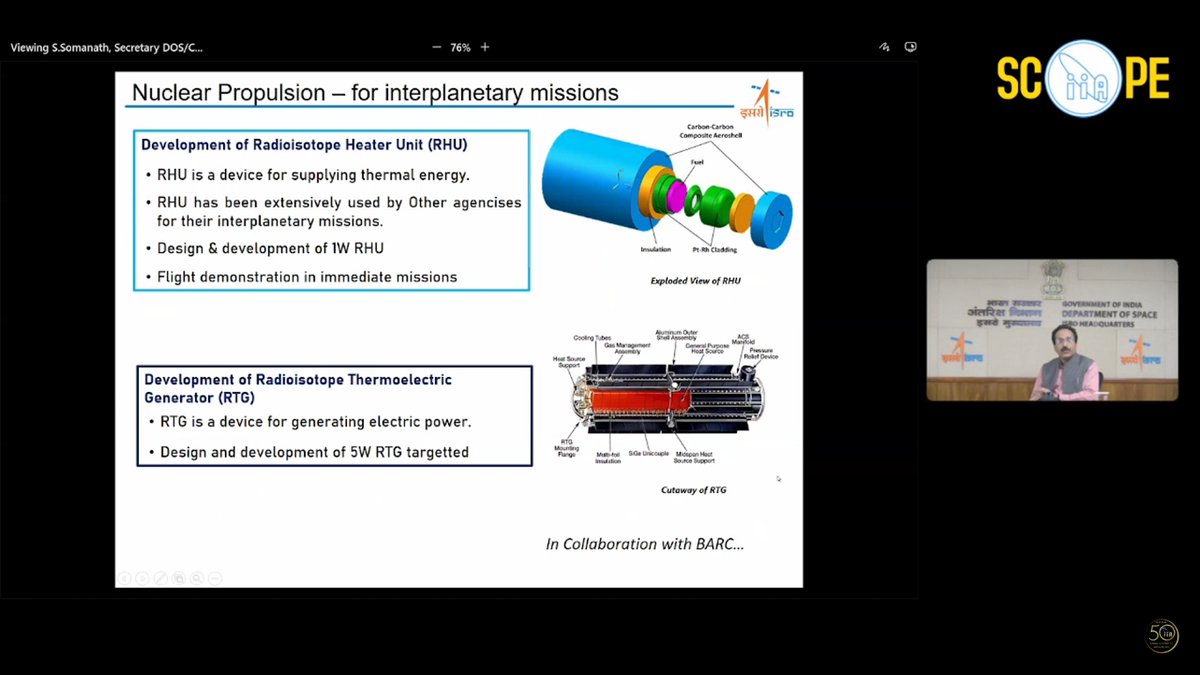
For those interested in technical details and physics background .. etc.. please keep reading.
Most NASA space probes have used Radioisotope Heater Units (RHUs) or Radioisotope Thermoelectric Generators (RTGs) to provide power and heat. RTGs use the heat generated by the radioactive decay of plutonium-238 to power spacecraft and keep their instruments warm...RHUs generally are there to keep electronics warm..(RHU are small - do not have thermocouples etc to generate electricity/power(
NASA has used RHUs or RTGs on over 50 space missions - starting in 1970's , including:
The Voyager 1 and 2 probes, which are still traveling through interstellar space
The Cassini-Huygens mission to Saturn and Titan
The Galileo mission to Jupiter
The Ulysses mission to the Sun's poles
The Mars Exploration Rovers Spirit and Opportunity
The New Horizons mission to Pluto and the Kuiper Belt
The James Webb Space Telescope
RHUs and RTGs are essential for missions to deep space or to planets and moons with cold environments. They are also used on some Earth-orbiting satellites and planetary landers.
According to NASA's RPS website, over 300 RHUs have been launched on a variety of NASA spacecraft. RTGs are larger and more powerful than RHUs, and are typically used on missions where more power is needed.
The same is true for Russian (or Soviet Union) - again *many* dozens probes...
Eg: Venera 9 and 10 (first spacecraft to land on Venus)
Luna 16 and 20, which returned samples of lunar soil to Earth
Phobos 1 and 2, which were missions to Mars
Mars 96, which was a failed mission to Mars
Phobos-Grunt, which was a failed mission to Phobos..
---
Chinese are using it on same scale - (Chang'e 5-T, Tianwen-1 etc).. they did not (from what I know) have technology to produce Pu-238 before and were depending on others.. but now they (CAST - China Academy of Space Technology) said that they have successfully developed a prototype RTG using Chinese-made plutonium-238. This is a significant development, as it means that China will no longer need to rely on foreign suppliers for RTGs.
---
India can produce its own plutonium-238 (Pu-238). BARC has developed a prototype radioisotope thermoelectric generator (RTG) using Pu-238, which is designed to be used on Chandrayaan type lunar orbiter.
India is strong in nuclear research and development, and it is one of the few countries in the world that can produce Pu-238. BARC has a dedicated Plutonium-238 Production Plant (P-238PP), which is used to produce Pu-238 for space applications.
The P-238PP uses a process called neutron irradiation to produce Pu-238. In this process, enriched uranium-238 is irradiated with neutrons in a nuclear reactor. This causes some of the uranium-238 atoms to absorb neutrons and transmute into Pu-238.
I have an earlier post in this dhaga about RHU - and India's status, and some ISRO slides..
(As I said earlier, Pu-238 producing is a little challenging task, Pu238 is different than Pu -239 used for 'other' purposes..)
Hope this is interesting to some folks here..
Adding an old slide from a post earlier:

Re: Chandrayaan 3: Launch and Discussions
@Amber G. ji
Why does the slide say "Nuclear propulsion"? RHU and RTG are used only to keep the electronics warm and run the electronic equipment respectively. Isn't "nuclear propulsion" something like ion engine or something like that?
Here are link to some Wikipedia pages which give an overview.
https://en.wikipedia.org/wiki/Nuclear_p ... Spacecraft
https://en.wikipedia.org/wiki/Ion_thruster
https://en.wikipedia.org/wiki/Spacecraf ... of_methods
Why does the slide say "Nuclear propulsion"? RHU and RTG are used only to keep the electronics warm and run the electronic equipment respectively. Isn't "nuclear propulsion" something like ion engine or something like that?
Here are link to some Wikipedia pages which give an overview.
https://en.wikipedia.org/wiki/Nuclear_p ... Spacecraft
https://en.wikipedia.org/wiki/Ion_thruster
https://en.wikipedia.org/wiki/Spacecraf ... of_methods
Re: Chandrayaan 3: Launch and Discussions
These are slides from Dr. Somnath .. (most likely slides are made by his assistant).. I will not describe them as part of 'nuclear propulsion. As you said, they should be called what they are - Radioisotopes units.Vayutuvan wrote: ↑03 Nov 2023 01:18 @Amber G. ji
Why does the slide say "Nuclear propulsion"? RHU and RTG are used only to keep the electronics warm and run the electronic equipment respectively. Isn't "nuclear propulsion" something like ion engine or something like that?
Here are link to some Wikipedia pages which give an overview.
https://en.wikipedia.org/wiki/Nuclear_p ... Spacecraft
https://en.wikipedia.org/wiki/Ion_thruster
https://en.wikipedia.org/wiki/Spacecraf ... of_methods
As you said, nuclear propulsion is something like ion engine,
Nuclear propulsion refers to the use of nuclear energy, typically from nuclear reactions, to propel spacecraft (and submarines, we do it now).. potentially future deep-space exploration vehicles.
There are two primary types of nuclear propulsion:
Nuclear Thermal Propulsion (NTP): (In NTP systems, nuclear reactors are used to heat a propellant, usually hydrogen, to high temperatures. The superheated propellant is then expelled through a rocket nozzle to generate thrust.
Nuclear Electric Propulsion (NEP): NEP systems use nuclear reactors to generate electricity, which is then used to power electric thrusters. These thrusters accelerate ionized propellant (usually xenon) to generate thrust. While NEP systems typically provide lower thrust compared to chemical rockets, they are highly efficient and can operate for extended periods, making them well-suited for long-duration missions in space, such as interplanetary travel.
In summary - from what I know - nuclear propulsion for space exploration is still under development and not yet in practical use.
---
USA has a long history of research and development in nuclear propulsion, both for space exploration and military applications. NASA has been researching nuclear thermal propulsion (NTP) and nuclear electric propulsion (NEP) technologies. The Space Launch System (SLS) program has been exploring the use of NTP for future deep-space missions.
Russia to has t experience with nuclear propulsion - NTP types for space. They have experimented with nuclear-powered spacecraft eg Soviet RORSAT series.
Not surprisingly India has also doing work in nuclear propulsion for space exploration. ISRO has conducted studies and research on nuclear thermal propulsion systems. There is lot of progress but from what I know it has not yet deployed operational nuclear propulsion systems.
(For details see the links given by Vaytuvan or other references etc..)
Re: Chandrayaan 3: Launch and Discussions
As per the wikipedia pages, Hall Effect thrusters were flight proven by Russians.
Re: Chandrayaan 3: Launch and Discussions
^^^ Thanks. Yes, Hall-effect thrusters (HETs) were flight-proven by the Russians. They have a history dating back several decades. (Hall-effect thrusters are a type of electric propulsion system that uses magnetic and electric fields to accelerate ionized propellant, xenon, to generate thrust.)
Roscosmos also used them (from what I know) for station-keeping, orbit raising, and other such tasks. The use of Hall-effect thrusters in Russian spacecraft has been successful in numerous missions, including geostationary satellites.
Hall-effect thrusters were initially developed by the Russian but now they are being used in other countries as they are somewhat fuel efficient.
India has been involved in research and development ... including these ion thrusters. ISRO) has conducted research into this and related ion propulsion systems.
ISRO's interest in such systems is primarily aimed at improving the efficiency of its satellites and interplanetary missions as they can provide advantages in terms of fuel efficiency and the ability to perform complex orbital maneuvers and deep space missions.
I do not have specific details on the extent of India's R&D one may want to check with more recent sources /ISRO website etc..
Roscosmos also used them (from what I know) for station-keeping, orbit raising, and other such tasks. The use of Hall-effect thrusters in Russian spacecraft has been successful in numerous missions, including geostationary satellites.
Hall-effect thrusters were initially developed by the Russian but now they are being used in other countries as they are somewhat fuel efficient.
India has been involved in research and development ... including these ion thrusters. ISRO) has conducted research into this and related ion propulsion systems.
ISRO's interest in such systems is primarily aimed at improving the efficiency of its satellites and interplanetary missions as they can provide advantages in terms of fuel efficiency and the ability to perform complex orbital maneuvers and deep space missions.
I do not have specific details on the extent of India's R&D one may want to check with more recent sources /ISRO website etc..
Re: Chandrayaan 3: Launch and Discussions
Since you are the most prolific & valued contributor to BRF's Space Threads, just wanted to give you a heads up...
1) The Economic & Technology Forum has been renamed to the Science, Economics & Technology (SET) Forum. This is to give the Space threads its rightful place (within the scope of technology) in the BR Forums. Space threads were getting lost in the Military Issues & History forum.
2) I have moved a bunch of space/science threads - including this one - to this forum. Please do review.
Thank You Amber G.
Re: Chandrayaan 3: Launch and Discussions
Cryogenic Upper Stage (CUS) has made an uncontrolled re-entry into the atmosphere
https://twitter.com/Chethan_Dash/status ... 1263212847
https://twitter.com/Chethan_Dash/status ... 1263212847
Re: Chandrayaan 3: Launch and Discussions
NASA Chief hails Chandrayaan 3, says 'US will land pvt landers on South Pole in 2024, but India was first...'
https://swarajyamag.com/news-brief/step ... pace-force
28 Nov 2023
https://swarajyamag.com/news-brief/step ... pace-force
28 Nov 2023
Re: Chandrayaan 3: Launch and Discussions
Chandrayaan-3 Mission:
Ch-3's Propulsion Module (PM) takes a successful detour!
In another unique experiment, the PM is brought from Lunar orbit to Earth’s orbit.
An orbit-raising maneuver and a Trans-Earth injection maneuver placed PM in an Earth-bound orbit.
Returns to home Earth: Chandrayaan-3 Propulsion Module moved from Lunar orbit to Earth's orbit

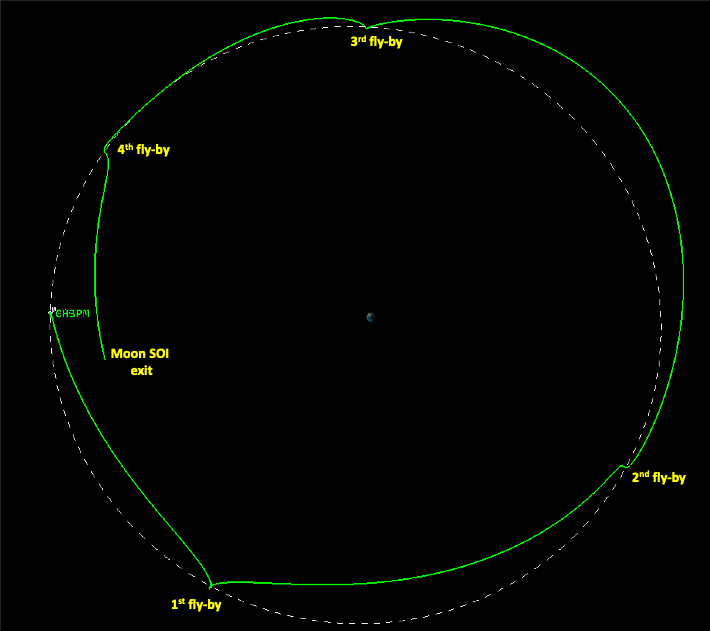
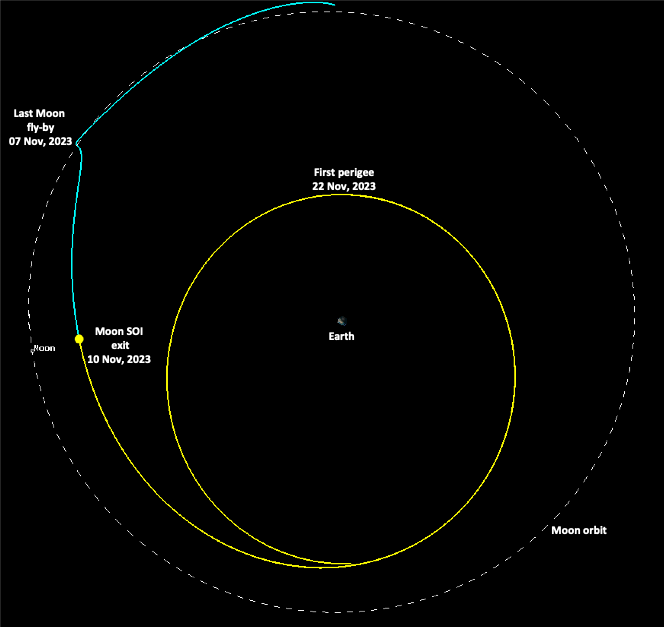
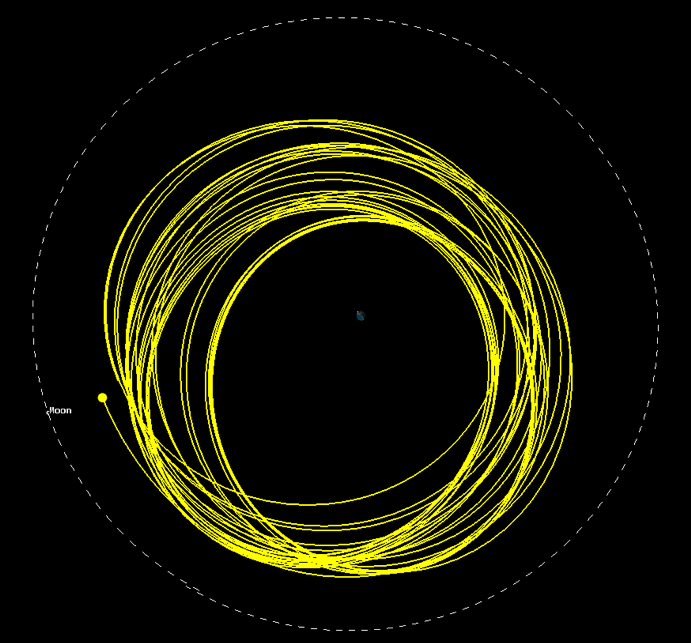
Ch-3's Propulsion Module (PM) takes a successful detour!
In another unique experiment, the PM is brought from Lunar orbit to Earth’s orbit.
An orbit-raising maneuver and a Trans-Earth injection maneuver placed PM in an Earth-bound orbit.
Returns to home Earth: Chandrayaan-3 Propulsion Module moved from Lunar orbit to Earth's orbit




Re: Chandrayaan 3: Launch and Discussions
Although orbiting earth, looks like apogee of PM is quite close to Moon's SoI (Sphere of influence).
Interesting they didnt bring it close to earth.
Re: Chandrayaan 3: Launch and Discussions
Chang'e-5' Propulsion Module moved to Sun-Earth L1 point after the sample return module entered Earth's orbit. These are cost-effective & innovative ways to utilize resources, just like the 4th Stage of PSLV. They may also contribute towards reducing space debris.
Re: Chandrayaan 3: Launch and Discussions
What was interesting to me, and I talked about a few times here is this dhaga was LRA ( Laser Retroreflector Array), supplied by NASA .. see my one of my earlier post below for background:
Well according to NASA and reports in newspapers:
Even though Vikram's batteries did not survive past lunar night-- Vikram lander started serving as a location marker near lunar south pole
Nasa’s Lunar Reconnaissance Orbiter (LRO) pings on Isro’s Vikram lander. The Chandrayaan-3 lander was 100km away from LRO, near Manzinus crater in the Moon’s South Pole region. The successful experiment paves the way for accurately locating targets on the moon's surface. NASA’s Laser Retroreflector Array (LRA) was fitted on the Vikram lander under international collaboration with ISRO. LRA serves as a simple but robust method to reflect incoming light from any direction back to its source.
My post:
Well according to NASA and reports in newspapers:
Even though Vikram's batteries did not survive past lunar night-- Vikram lander started serving as a location marker near lunar south pole
Nasa’s Lunar Reconnaissance Orbiter (LRO) pings on Isro’s Vikram lander. The Chandrayaan-3 lander was 100km away from LRO, near Manzinus crater in the Moon’s South Pole region. The successful experiment paves the way for accurately locating targets on the moon's surface. NASA’s Laser Retroreflector Array (LRA) was fitted on the Vikram lander under international collaboration with ISRO. LRA serves as a simple but robust method to reflect incoming light from any direction back to its source.
My post:
Amber G. wrote: ↑06 Aug 2023 20:10 One of the CY3' Vikram/Pragyan pay load interesting to me is LRA ( Laser Retroreflector Array), supplied by NASA. This is passive instrument (requires no batteries etc), weighs only about 20 gms (about 3 gm on the moon). LRA consists of eight tiny retroreflectors affixed to a hemispherical platform attached to the Vikram. The device, when struck by laser light, reflects the light back to its source to reveal its location - precise location! The device, I think is too small to be used by lasers from earth (at least now) but from PM (or other space-crafts) can be use it to locate it exactly even if everything else is not working.
LRAs can be used as precision landmarks for guidance and navigation during the lunar day or night. In the future, by placing a few LRAs around a specific site they can guide arriving robotic or human-carrying landers to a safe, pinpoint landing.
Other payloads: ChaSTE, ILSA, Langmuir Probe, APXS, LIBS etc have been talked about but I have not heard much about LRA so posting it here.
Re: Chandrayaan 3: Launch and Discussions
PM Modiji congratulate Japan:
.Cngratulations Prime Minister @Kishida230 and everyone at JAXA on achieving Japan’s first soft Moon landing. India looks forward to our cooperation in space exploration between @isro
and JAXA
Re: Chandrayaan 3: Launch and Discussions
NASA LRO pings CY3 retroreflector
Re: Chandrayaan 3: Launch and Discussions
Happy to see that: Japan's Moon lander, SLIM, has resumed operations after power was restored.
Re: Chandrayaan 3: Launch and Discussions

SLIM lander has survived the lunar night. It responded to commands sent by mission control.
My guess is, its upside down orientation with part of the body touching the lunar surface has somehow helped it to retain heat.
IM's NOVA C is also lying on its side touching the lunar surface. Lets see if it can also survive the lunar night.
Re: Chandrayaan 3: Launch and Discussions
Remember I posted about CH3 PM takes "successful detour" - See post below for more detials..
Well: Chandrayaan3 Propulsion Module is still sending a strong signal from its distant Earth orbit as it continues the SHAPE experiment.
CH3PM is presently about 225000 km distant... As measured by radio-telescope ,,!!
Running the polarimeter this night to see if it does anything interesting. See https://ursc.gov.in/shape.jsp
CH3PM moved from lunar orbit to a 'stable' high Earth orbit just inside the from the Moon's nominal distance see here for more details
Here is my original post .. (About 3 months ago).
Well: Chandrayaan3 Propulsion Module is still sending a strong signal from its distant Earth orbit as it continues the SHAPE experiment.
CH3PM is presently about 225000 km distant... As measured by radio-telescope ,,!!
Running the polarimeter this night to see if it does anything interesting. See https://ursc.gov.in/shape.jsp
CH3PM moved from lunar orbit to a 'stable' high Earth orbit just inside the from the Moon's nominal distance see here for more details
Here is my original post .. (About 3 months ago).
Amber G. wrote: ↑05 Dec 2023 19:54 Chandrayaan-3 Mission:
Ch-3's Propulsion Module (PM) takes a successful detour!
In another unique experiment, the PM is brought from Lunar orbit to Earth’s orbit.
An orbit-raising maneuver and a Trans-Earth injection maneuver placed PM in an Earth-bound orbit.
Returns to home Earth: Chandrayaan-3 Propulsion Module moved from Lunar orbit to Earth's orbit

Re: Chandrayaan 3: Launch and Discussions
Have started a new thread for Chandrayaan-4.
Re: Chandrayaan 3: Launch and Discussions
Meanwhile: As expected: The International Astronomical Union (IAU)approves Chandrayaan-3 landing site name 'Shiva Shakti'
Re: Chandrayaan 3: Launch and Discussions
Japan's SLIM lander has survived the 2nd Lunar night.
Must be having robust insulation and design margins for electronics, battery and cameras to survive -130 C and still wake up and send pictures.
https://www.space.com/japan-slim-moon-l ... unar-night
Must be having robust insulation and design margins for electronics, battery and cameras to survive -130 C and still wake up and send pictures.
https://www.space.com/japan-slim-moon-l ... unar-night
"According to the acquired data, some temperature sensors and unused battery cells are starting to malfunction, but the majority of functions that survived the first lunar night was mantained even after the second lunar night!" mission team members said in another X post on Wednesday night.